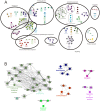Pronounced effects of acute endurance exercise on gene expression in resting and exercising human skeletal muscle
- PMID: 23226462
- PMCID: PMC3511348
- DOI: 10.1371/journal.pone.0051066
Pronounced effects of acute endurance exercise on gene expression in resting and exercising human skeletal muscle
Abstract
Regular physical activity positively influences whole body energy metabolism and substrate handling in exercising muscle. While it is recognized that the effects of exercise extend beyond exercising muscle, it is unclear to what extent exercise impacts non-exercising muscles. Here we investigated the effects of an acute endurance exercise bouts on gene expression in exercising and non-exercising human muscle. To that end, 12 male subjects aged 44-56 performed one hour of one-legged cycling at 50% W(max). Muscle biopsies were taken from the exercising and non-exercising leg before and immediately after exercise and analyzed by microarray. One-legged cycling raised plasma lactate, free fatty acids, cortisol, noradrenalin, and adrenalin levels. Surprisingly, acute endurance exercise not only caused pronounced gene expression changes in exercising muscle but also in non-exercising muscle. In the exercising leg the three most highly induced genes were all part of the NR4A family. Remarkably, many genes induced in non-exercising muscle were PPAR targets or related to PPAR signalling, including PDK4, ANGPTL4 and SLC22A5. Pathway analysis confirmed this finding. In conclusion, our data indicate that acute endurance exercise elicits pronounced changes in gene expression in non-exercising muscle, which are likely mediated by changes in circulating factors such as free fatty acids. The study points to a major influence of exercise beyond the contracting muscle.
Conflict of interest statement
Figures






References
-
- Valkeinen H, Aaltonen S, Kujala UM (2010) Effects of exercise training on oxygen uptake in coronary heart disease: a systematic review and meta-analysis. Scandinavian Journal of Medicine & Science in Sports 20: 545–555. - PubMed
-
- Farid R, Azad FJ, Atri AE, Rahimi MB, Khaledan A, et al. (2005) Effect of aerobic exercise training on pulmonary function and tolerance of activity in asthmatic patients. Iran J Allergy Asthma Immunol 4: 133–138. - PubMed
-
- Buono MJ, Constable SH, Morton AR, Rotkis TC, Stanforth PR, et al. (1981) The effect of an acute bout of exercise on selected pulmonary function measurements. Med Sci Sports Exerc 13: 290–293. - PubMed
-
- Thompson D, Karpe F, Lafontan M, Frayn K (2012) Physical Activity and Exercise in the Regulation of Human Adipose Tissue Physiology. Physiological Reviews 92: 157–191. - PubMed
-
- Zanchi NE, Lira FS, Seelaender M, Lancha-Jr AH (2010) Experimental chronic low-frequency resistance training produces skeletal muscle hypertrophy in the absence of muscle damage and metabolic stress markers. Cell Biochemistry and Function 28: 232–238. - PubMed
Publication types
MeSH terms
Substances
LinkOut - more resources
Full Text Sources
Other Literature Sources
Medical
Molecular Biology Databases

